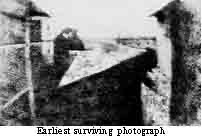The first permanent photographic image was produced in 1825 by Joseph Nicephore Niepce. The French inventor produced his photographs on a polished pewter plate covered with a petroleum derivative called bitumen of Judea. As the Bitumen hardens with exposure to light. The unhardened material was then washed away and the metal plate polished, rendering a negative image which then may be coated with ink and impressed upon paper, producing a print.
image view from the window The earliest surviving photograph circa 1826 can be seen on the left Click Here for a larger image In 1833 Niepce died of a stroke but not before leaving his notes to Louis Daguerre who further refined the process by a discovery made in 1724 that a silver and chalk mixture darkens when exposed to light. By 1839 he had discovered that exposing the silver first to iodine vapor before exposing to light, and then to mercury fumes after the photograph was taken, could form an image. he then used a bath of salt to fix the image. Daguerre had invented a process of using silver on a copper plate called the Daguerreotype.
This is a similar process still used today for Polaroid photos. Also in 1832 a French-Brazilian inventor named as Hercules Florence had already created a similar process naming it Photographie.
Also in 1839 Fox Talbot made a key improvement to the fixer, he used hyposulfite of soda known as hypo, or now sodium thiosulfate. Later that year, John Herschel the astronomer who had also worked with hyposulfite, made the first glass negative.
By 1840 things are moving on at a fast pace Fox Talbot had invented the collotype process. He coated sheets of paper with silver chloride to create an intermediate image. Unlike a Daguerreotype, a Collotype negative was used to produce a positive image much like most chemical films still do today.
Talbot took out a patent on this system, which was to largely limit its adoption. He spent a lot of his life defending lawsuits on the patent. In the end he gave up photography. George Eastman much refined Talbot's process. The same basic technology is still in use today.
So there you have it, that's the very basic history of chemical photography, I could have started off with the pinhole camera thought to date back to the 5th century, but as these cameras did not record an image, they only projected images on a surface. I have given you a brief insight to the history of what we now call film.
